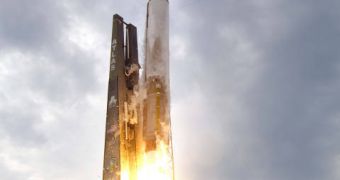After a large number of delays, NASA's mission to the Moon, comprised of the Lunar Reconnaissance Orbiter (LRO) and the Lunar Crater Observation and Sensing Spacecraft (LCROSS), has finally made it to its destination. Following the June 18th launch, the Atlas V delivery system carried the two spacecraft safely to their destination on the orbit of the Moon, where LRO will remain for the next few years. This morning, at around 6:30 am EDT (1030 GMT), LRO successfully completed a series of engine burns, which were directed by controllers at the Goddard Space Flight Center, in Greenbelt, Maryland.
Following five days of non-stop flight from low-Earth orbit to the Moon, LRO arrived at its destination unharmed and in tip-top condition, early telemetry reports suggest. At around 5:47 am EDT (0947 GMT) this morning, the probe started firing its thrusters in specific sequences, in a process that lasted a little under 40 minutes. Over the next few days, mission controllers have announced, its science instruments will be progressively turned on, and the craft will reach its final orbit around the natural satellite.
On the other hand, the $79-million LCROSS has not yet made it to the Moon. It's currently attached to an empty Centaur rocket stage, which acts like ballast. The probe will slingshot past the Moon later today, at around 8:20 am EDT (1220 GMT), and will enter an orbit that will eventually lead to their crashing into the lunar surface. The LCROSS impactor will plummet towards the Moon on October 9th, when the debris cloud generated by the crash will be analyzed with every available spectrograph, which will look for signs of liquid or frozen water.
“This whole new moon we're ready to see is out there waiting, and this mission is going to go get it,” NASA's Goddard Chief Scientist, Jim Garvin, shares. “We are in lunar orbit. We're not going past the moon. We're there to stay,” NASA Goddard Space Flight Center LRO Project Scientist Richard Vondrak adds. “It went like clockwork. In the end, it went exactly as planned,” Craig Tooley, the LRO project manager at the American space agency, concludes, as quoted by Space.

 14 DAY TRIAL //
14 DAY TRIAL //